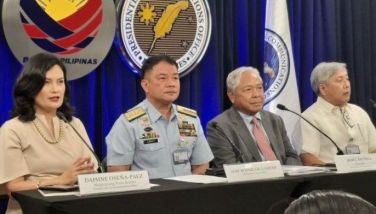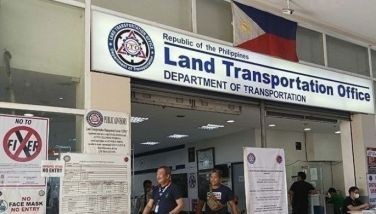ASCOPE eyes full integration of gas pipelines by 2020
November 9, 2001 | 12:00am
KUALA LUMPUR, Malaysia – The ASEAN Council on Petroleum (ASCOPE) expects the gas pipelines in the region to be fully integrated by 2020.
ASCOPE trans-ASEAN gas pipeline (TAGP) task force lead coordinator Farid Mohamed Amin said there are seven new pipeline interconnections now being studied.
These are the South Sumatera, Indonesia-Malaysia pipeline; West Natuna, Indonesia-Duyong, Malaysia pipeline; East Natuna, Indonesia-JDA-Erawan, Thailand pipeline; East Nabuna, Indonesia-Singapore pipeline; East Natuna, Indonesia-Sabah, Malaysia, Palawan-Luzon, Philippines pipeline; Malaysia-Thailand JDA-Block B pipeline; and Peninsular Malaysia-Arun, Sumatera, Indonesia pipeline.
The ASCOPE TAGP task force was set up in late 1999 to formulate strategies for the implementation and realization of the TAGP infrastructure with a view to enhancing greater energy security in the ASEAN.
Amin said member countries like Malaysia, Singapore, Thailand, Philippines and Vietnam should thoroughly study the market for natural gas especially if they plan to import natural gas to meet their energy requirements.
He also encouraged ASCOPE member-countries to forge joint ventures and strategic alliances between companies to capitalize on such energy opportunities to develop the gas pipeline interconnection.
He said most of the gas pipeline interconnections are to be undertaken based on bilateral arrangements between gas seller and buyer. Amin estimated that the total cost of the gas pipeline infrastructure including compression and platform, excluding drilling costs, with a total distance of more than 4,000 kilometers, would be $7 billion.
According to Amin, the development of Trans-ASEAN gas pipeline infrastructure could create attractive incentives for multinational oil companies to further invest in gas exploration initiatives.
The development of a gas transmission, he said, would encourage the enhancement of stranded gas fields whose smaller size may not be commercially attractive without such infrastructure.
He said greater investment opportunities in exploration and development could and should be created for the multinational companies to discover more gas resources in the region and thus help to enhance energy security for the region as well as satisfy the need of demand centers.
He further noted that the implementation of the projects would spur further economic development and growth in the region, which in turn will create other spin-offs and business opportunities and benefits could be measured in terms of economic development and growth, improvement in the environment, more efficient energy use and increased energy security.
ASCOPE trans-ASEAN gas pipeline (TAGP) task force lead coordinator Farid Mohamed Amin said there are seven new pipeline interconnections now being studied.
These are the South Sumatera, Indonesia-Malaysia pipeline; West Natuna, Indonesia-Duyong, Malaysia pipeline; East Natuna, Indonesia-JDA-Erawan, Thailand pipeline; East Nabuna, Indonesia-Singapore pipeline; East Natuna, Indonesia-Sabah, Malaysia, Palawan-Luzon, Philippines pipeline; Malaysia-Thailand JDA-Block B pipeline; and Peninsular Malaysia-Arun, Sumatera, Indonesia pipeline.
The ASCOPE TAGP task force was set up in late 1999 to formulate strategies for the implementation and realization of the TAGP infrastructure with a view to enhancing greater energy security in the ASEAN.
Amin said member countries like Malaysia, Singapore, Thailand, Philippines and Vietnam should thoroughly study the market for natural gas especially if they plan to import natural gas to meet their energy requirements.
He also encouraged ASCOPE member-countries to forge joint ventures and strategic alliances between companies to capitalize on such energy opportunities to develop the gas pipeline interconnection.
He said most of the gas pipeline interconnections are to be undertaken based on bilateral arrangements between gas seller and buyer. Amin estimated that the total cost of the gas pipeline infrastructure including compression and platform, excluding drilling costs, with a total distance of more than 4,000 kilometers, would be $7 billion.
According to Amin, the development of Trans-ASEAN gas pipeline infrastructure could create attractive incentives for multinational oil companies to further invest in gas exploration initiatives.
The development of a gas transmission, he said, would encourage the enhancement of stranded gas fields whose smaller size may not be commercially attractive without such infrastructure.
He said greater investment opportunities in exploration and development could and should be created for the multinational companies to discover more gas resources in the region and thus help to enhance energy security for the region as well as satisfy the need of demand centers.
He further noted that the implementation of the projects would spur further economic development and growth in the region, which in turn will create other spin-offs and business opportunities and benefits could be measured in terms of economic development and growth, improvement in the environment, more efficient energy use and increased energy security.
BrandSpace Articles
<
>
- Latest
- Trending
Trending
Latest
Trending
Latest
Recommended
































